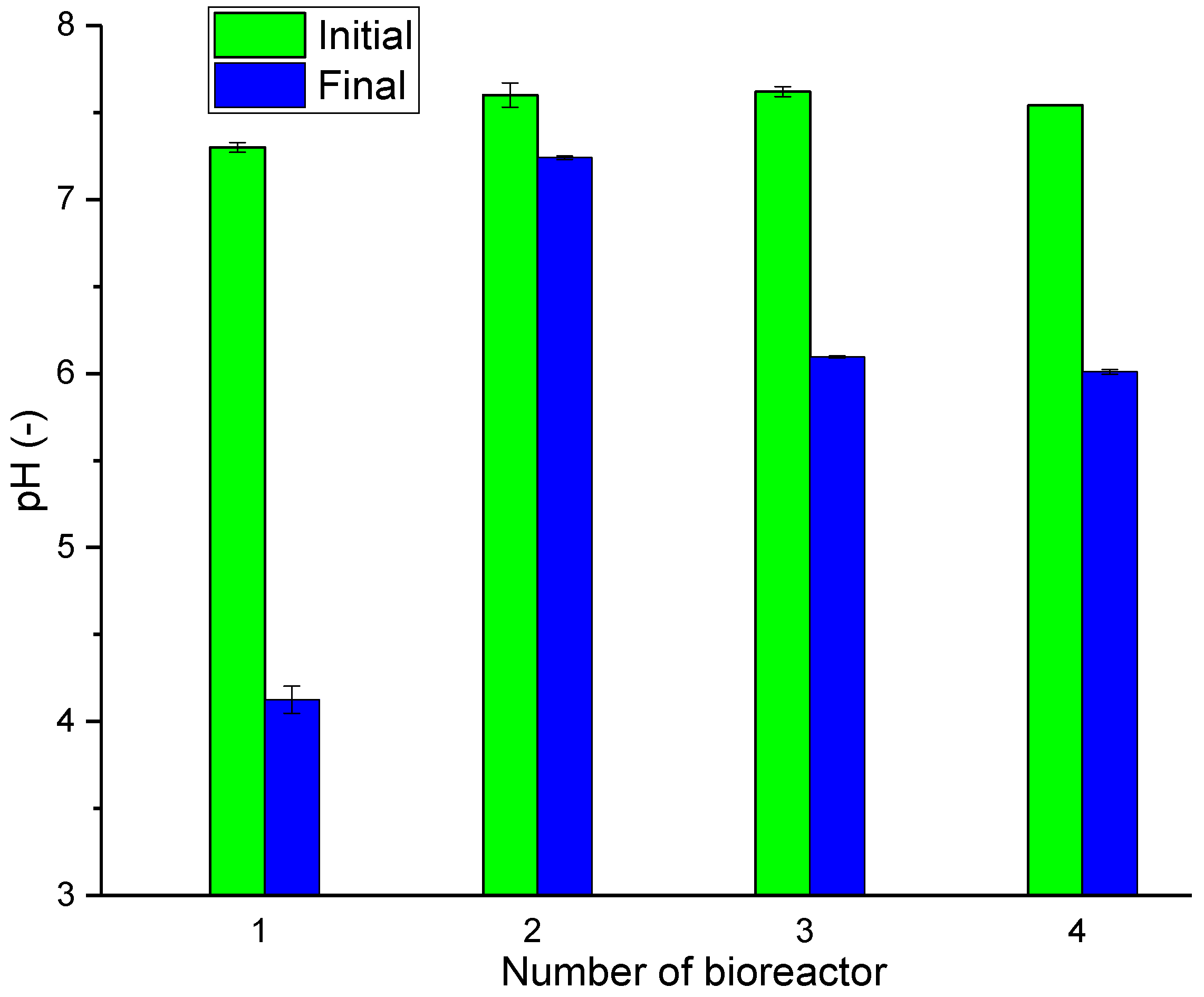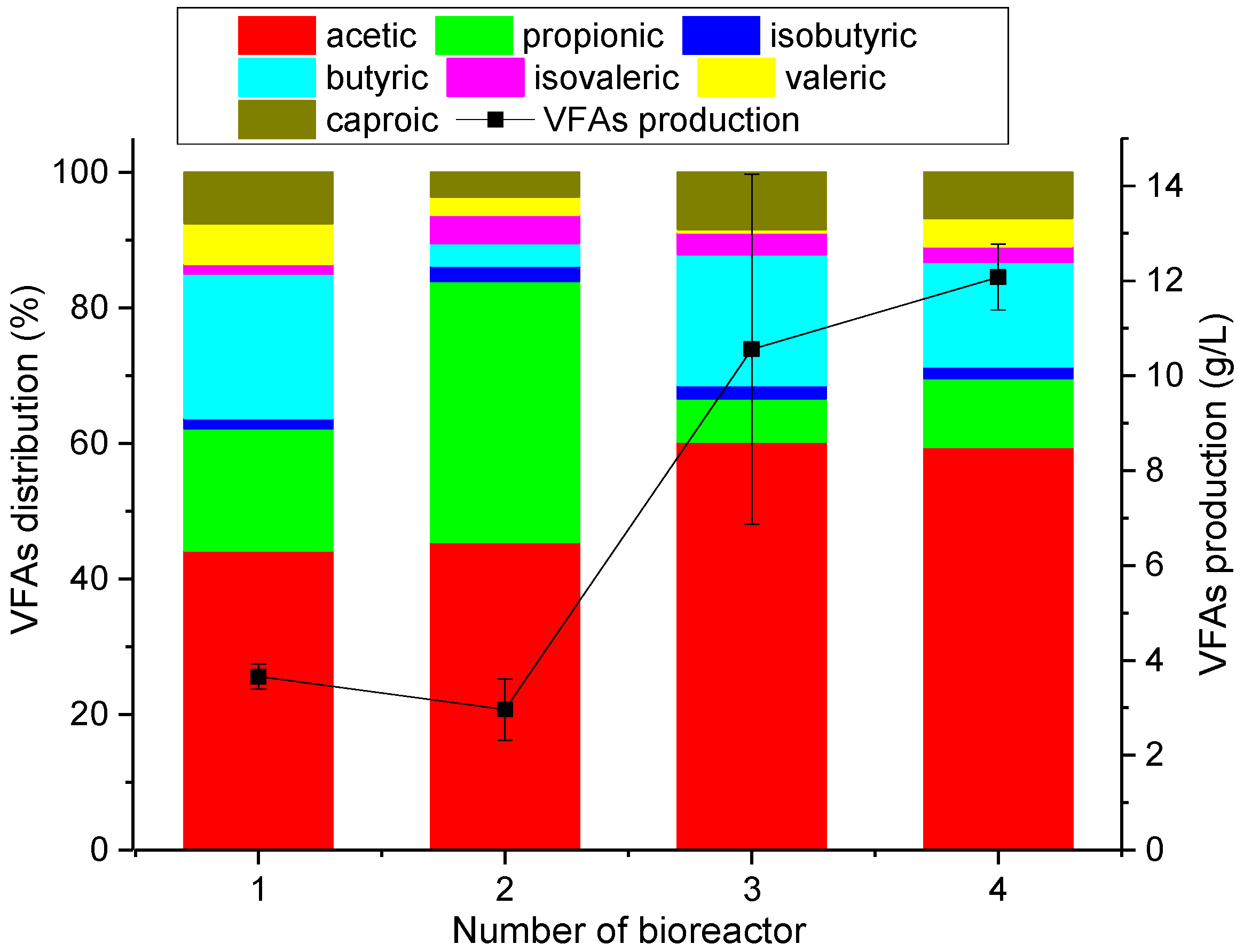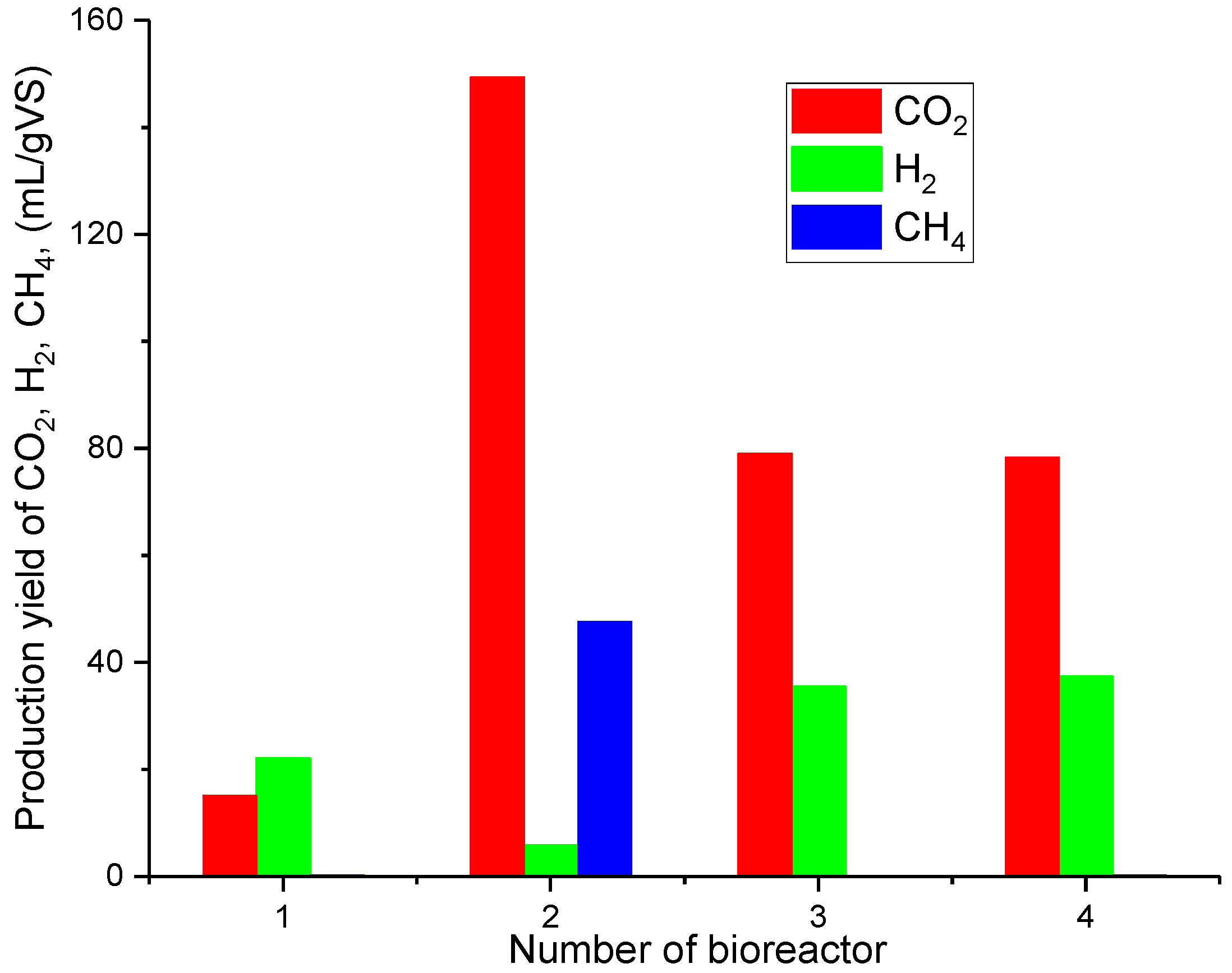Influence of Inoculum Thermal Pretreatment Time on Hydrogen Production in Dark Fermentation †
Abstract
:1. Introduction
2. Materials and Methods
2.1. Substrate and Inoculum
2.2. Experimental Set-Up and Procedure
2.3. Analytical Methods
3. Results and Discussion
3.1. Changes in pH
3.2. Production of VFAs
3.3. Production of CO2, H2 and CH4
3.4. Carbon Balance
4. Conclusions
Author Contributions
Funding
Data Availability Statement
Acknowledgments
Conflicts of Interest
References
- Guo, X.M.; Trably, E.; Latrille, E.; Carrère, H.; Steyer, J.-P. Hydrogen Production from Agricultural Waste by Dark Fermentation: A Review. Int. J. Hydrogen Energy 2010, 35, 10660–10673. [Google Scholar] [CrossRef]
- Ni, M.; Leung, D.Y.C.; Leung, M.K.H.; Sumathy, K. An Overview of Hydrogen Production from Biomass. Fuel Process. Technol. 2006, 87, 461–472. [Google Scholar] [CrossRef]
- Wang, C.; Chang, Y.; Zhang, L.; Pang, M.; Hao, Y. A Life-Cycle Comparison of the Energy, Environmental and Economic Impacts of Coal versus Wood Pellets for Generating Heat in China. Energy 2017, 120, 374–384. [Google Scholar] [CrossRef]
- Piera, M.; Martínez-Val, J.M.; José Montes, M. Safety Issues of Nuclear Production of Hydrogen. Energy Convers. Manag. 2006, 47, 2732–2739. [Google Scholar] [CrossRef]
- Pańczyk, M.; Borowiecki, T. Otrzymywanie i Zastosowanie Gazu Syntezowego. In Zakład Technologii Chemicznej; Wydział Chemii Uniwersytetu w Lublinie: Lublin, Poland, 2012. [Google Scholar]
- Ausfelder, F.; Bazzanella, A. Hydrogen in the Chemical Industry. In Hydrogen Science and Engineering: Materials, Processes, Systems and Technology; Wiley: Hoboken, NJ, USA, 2016; pp. 19–40. [Google Scholar] [CrossRef]
- Samanta, C. Direct Synthesis of Hydrogen Peroxide from Hydrogen and Oxygen: An Overview of Recent Developments in the Process. Appl. Catal. A Gen. 2008, 350, 133–149. [Google Scholar] [CrossRef]
- Rahman, S.N.A.; Masdar, M.S.; Rosli, M.I.; Majlan, E.H.; Husaini, T.; Kamarudin, S.K.; Daud, W.R.W. Overview Biohydrogen Technologies and Application in Fuel Cell Technology. Renew. Sustain. Energy Rev. 2016, 66, 137–162. [Google Scholar] [CrossRef]
- Tian, Q.-Q.; Liang, L.; Zhu, M.-J. Enhanced Biohydrogen Production from Sugarcane Bagasse by Clostridium Thermocellum Supplemented with CaCO3. Bioresour. Technol. 2015, 197, 422–428. [Google Scholar] [CrossRef]
- Srivastava, N.; Srivastava, M.; Abd_Allah, E.F.; Singh, R.; Hashem, A.; Gupta, V.K. Biohydrogen Production Using Kitchen Waste as the Potential Substrate: A Sustainable Approach. Chemosphere 2021, 271, 129537. [Google Scholar] [CrossRef]
- Gopalakrishnan, B.; Khanna, N.; Das, D. Dark-Fermentative Biohydrogen Production. In Biohydrogen; Elsevier: Amsterdam, The Netherlands, 2019. [Google Scholar] [CrossRef]
- Holladay, J.D.; Hu, J.; King, D.L.; Wang, Y. An Overview of Hydrogen Production Technologies. Catal. Today 2009, 139, 244–260. [Google Scholar] [CrossRef]
- Baeyens, J.; Zhang, H.; Nie, J.; Appels, L.; Dewil, R.; Ansart, R.; Deng, Y. Reviewing the Potential of Bio-Hydrogen Production by Fermentation. Renew. Sustain. Energy Rev. 2020, 131, 110023. [Google Scholar] [CrossRef]
- Eurostat. Key Figures on the EU in the World–2023 Edition. Available online: https://ec.europa.eu/eurostat/web/products-key-figures/w/ks-ex-23-001 (accessed on 12 December 2023).
- Jain, A.; Sarsaiya, S.; Kumar Awasthi, M.; Singh, R.; Rajput, R.; Mishra, U.C.; Chen, J.; Shi, J. Bioenergy and Bio-Products from Bio-Waste and Its Associated Modern Circular Economy: Current Research Trends, Challenges, and Future Outlooks. Fuel 2022, 307, 121859. [Google Scholar] [CrossRef]
- Tapia-Venegas, E.; Ramirez-Morales, J.E.; Silva-Illanes, F.; Toledo-Alarcón, J.; Paillet, F.; Escudie, R.; Lay, C.-H.; Chu, C.-Y.; Leu, H.-J.; Marone, A.; et al. Biohydrogen Production by Dark Fermentation: Scaling-up and Technologies Integration for a Sustainable System. Rev. Environ. Sci. Bio/Technol. 2015, 14, 761–785. [Google Scholar] [CrossRef]
- Rafieenia, R.; Lavagnolo, M.C.; Pivato, A. Pre-Treatment Technologies for Dark Fermentative Hydrogen Production: Current Advances and Future Directions. Waste Manag. 2018, 71, 734–748. [Google Scholar] [CrossRef] [PubMed]
- Lee, W.S.; Chua, A.S.M.; Yeoh, H.K.; Ngoh, G.C. A Review of the Production and Applications of Waste-Derived Volatile Fatty Acids. Chem. Eng. J. 2014, 235, 83–99. [Google Scholar] [CrossRef]
- Pagliaccia, P.; Gallipoli, A.; Gianico, A.; Montecchio, D.; Braguglia, C.M. Single Stage Anaerobic Bioconversion of Food Waste in Mono and Co-Digestion with Olive Husks: Impact of Thermal Pretreatment on Hydrogen and Methane Production. Int. J. Hydrogen Energy 2016, 41, 905–915. [Google Scholar] [CrossRef]
- Arain, M.; Mahar, R.B.; Sahito, A.R. Biohydrogen Production from Co-Digestion of High Carbohydrate Containing Food Waste and Combined Primary and Secondary Sewage Sludge. Mehran Univ. Res. J. Eng. Technol. 2018, 37, 139–148. [Google Scholar] [CrossRef]
- Alibardi, L.; Cossu, R. Composition Variability of the Organic Fraction of Municipal Solid Waste and Effects on Hydrogen and Methane Production Potentials. Waste Manag. 2015, 36, 147–155. [Google Scholar] [CrossRef]
- Ji, J.; Cai, Z.; Shen, L. Comparison Analysis on Biohydrogen Production of Mesophilic and Thermophilic Dark Fermentation Using Nickel Doped Lanthanum-Iron Oxide Nanoparticles as Supplementation. Int. J. Hydrogen Energy 2024, 49, 90–106. [Google Scholar] [CrossRef]
- Hidalgo, D.; Pérez-Zapatero, E.; Martín-Marroquín, J. Comparative Effect of Acid and Heat Inoculum Pretreatment on Dark Fermentative Biohydrogen Production. Environ. Res. 2023, 239, 117433. [Google Scholar] [CrossRef]
- Slezak, R.; Grzelak, J.; Krzystek, L.; Ledakowicz, S. Production of Volatile Fatty Acids and H2 for Different Ratio of Inoculum to Kitchen Waste. Environ. Technol. 2019, 41, 3767–3777. [Google Scholar] [CrossRef]
- APHA. Standard Methods for the Examination of Water and Wastewater, 21st ed.; American Public Health Association: Washington, DC, USA, 2005. [Google Scholar]
- Pramanik, S.K.; Suja, F.B.; Zain, S.M.; Pramanik, B.K. The Anaerobic Digestion Process of Biogas Production from Food Waste: Prospects and Constraints. Bioresour. Technol. Rep. 2019, 8, 100310. [Google Scholar] [CrossRef]
- Lay, J. Influence of Chemical Nature of Organic Wastes on Their Conversion to Hydrogen by Heat-Shock Digested Sludge. Int. J. Hydrogen Energy 2003, 28, 1361–1367. [Google Scholar] [CrossRef]
- Ślęzak, R.; Domińska, M.; Świątkiewicz, J.; Paździor, K.; Ledakowicz, S. Influence of Inoculum Thermal Pretreatment on Hydrogen Production in Dark Fermentation Process. In Proceedings of the 24th Polish Conference of Chemical and Process Engineering, Szczecin, Poland, 13–16 June 2023; pp. 56–57. [Google Scholar]
- Jayalakshmi, S.; Sukumaran, V.; Joseph, K. Enhancement of Hydrogen Production from Kitchen Waste Using Heat Treated Anaerobic Biogas Plant Slurry with PH Control. Int. J. Environ. Sustain. Dev. 2009, 8, 23–35. [Google Scholar] [CrossRef]




| Process | Substrate | Organism | Efficiency | ||
|---|---|---|---|---|---|
| Chemical/refinery | Ammonia reforming | Ammonia | - | no data | |
| Aqueous phase reforming | Carbohydrates | - | 35–55% | ||
| Steam reforming | Hydrocarbons | - | 70–85% | ||
| Partial oxidation | Hydrocarbons | - | 60–75% | ||
| Autothermal reforming | Hydrocarbons | - | 60–75% | ||
| Plasma reforming | Hydrocarbons | - | 9–85% | ||
| Biological | Bioelectrochemical system | Microbial electrolysis cell | Biomass + electricity | Exoelectrogens | 78% |
| Biophotolysis | Direct photolysis | Water + sunlight + biomass |
| 0.5% | |
| Indirect biophotolysis | Water + sunlight + biomass |
| 0.5% | ||
| Fermentation | Photo fermentation | Biomass + sunlight |
| 0.1% | |
| Dark fermentation | Biomass |
| 5% | ||
| Biomass gasification | Biomass | - | 35–50% | ||
| Water | Alkaline electrolyzer | H2O + electricity | - | 50–60% | |
| PEM electrolyzer | H2O + electricity | - | 55–70% | ||
| Solid oxide electrolysis cells | H2O + electricity | - | 40–60% | ||
| Thermochemical water splitting | H2O + heat | - | no data | ||
| Photoelectrochemical water slitting | H2O + sunlight | - | 12.4% | ||
| pH | Total Solids (g/L) | Volatile Solids (g/L) | Carbon (%TS) |
|---|---|---|---|
| 7.85 ± 0.05 | 31.46 ± 0.33 | 20.06 ± 0.29 | 48.91 ± 0.49 |
| pH | Total Solids (g/L) | Volatile Solids (g/L) | Carbon (%TS) |
|---|---|---|---|
| 4.41 ± 0.09 | 178.3 ± 4.5 | 165.1 ± 3.9 | 32.72 ± 0.06 |
| Bioreactor No. | 1 | 2 | 3 | 4 | |
|---|---|---|---|---|---|
| Start | Solid fraction (gC/L) | 3.67 | 8.18 | 8.99 | 8.33 |
| Liquid fraction (gC/L) | 1.62 | 1.72 | 2.08 | 2.07 | |
| Sum (gC/L) | 5.29 | 9.90 | 11.06 | 10.40 | |
| End | Solid fraction (gC/L) | 2.65 | 6.13 | 6.75 | 6.60 |
| Liquid fraction (gC/L) | 3.23 | 1.69 | 4.21 | 5.45 | |
| Gas fraction—CO2 (gC/L) | 0.11 | 1.09 | 0.58 | 0.57 | |
| Gas fraction—CH4 (gC/L) | 0.00 | 0.35 | 0.00 | 0.00 | |
| Sum (gC/L) | 5.99 | 9.26 | 11.54 | 12.62 | |
| Error (%) | 13.23 | −6.46 | 4.25 | 21.35 | |
Disclaimer/Publisher’s Note: The statements, opinions and data contained in all publications are solely those of the individual author(s) and contributor(s) and not of MDPI and/or the editor(s). MDPI and/or the editor(s) disclaim responsibility for any injury to people or property resulting from any ideas, methods, instructions or products referred to in the content. |
© 2024 by the authors. Licensee MDPI, Basel, Switzerland. This article is an open access article distributed under the terms and conditions of the Creative Commons Attribution (CC BY) license (https://creativecommons.org/licenses/by/4.0/).
Share and Cite
Domińska, M.; Ślęzak, R.; Świątkiewicz, J.; Paździor, K.; Ledakowicz, S. Influence of Inoculum Thermal Pretreatment Time on Hydrogen Production in Dark Fermentation. Energies 2024, 17, 974. https://doi.org/10.3390/en17040974
Domińska M, Ślęzak R, Świątkiewicz J, Paździor K, Ledakowicz S. Influence of Inoculum Thermal Pretreatment Time on Hydrogen Production in Dark Fermentation. Energies. 2024; 17(4):974. https://doi.org/10.3390/en17040974
Chicago/Turabian StyleDomińska, Marlena, Radosław Ślęzak, Justyna Świątkiewicz, Katarzyna Paździor, and Stanisław Ledakowicz. 2024. "Influence of Inoculum Thermal Pretreatment Time on Hydrogen Production in Dark Fermentation" Energies 17, no. 4: 974. https://doi.org/10.3390/en17040974





